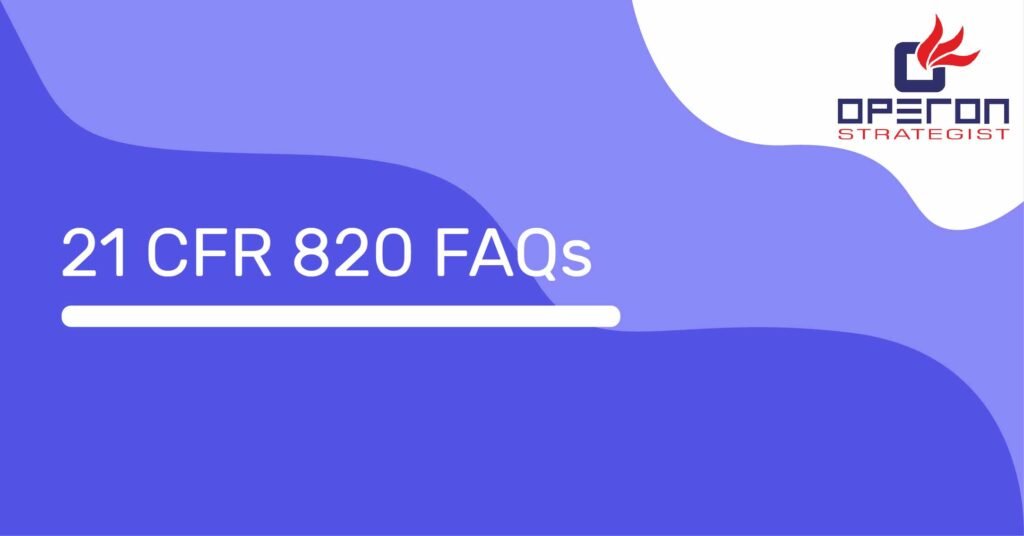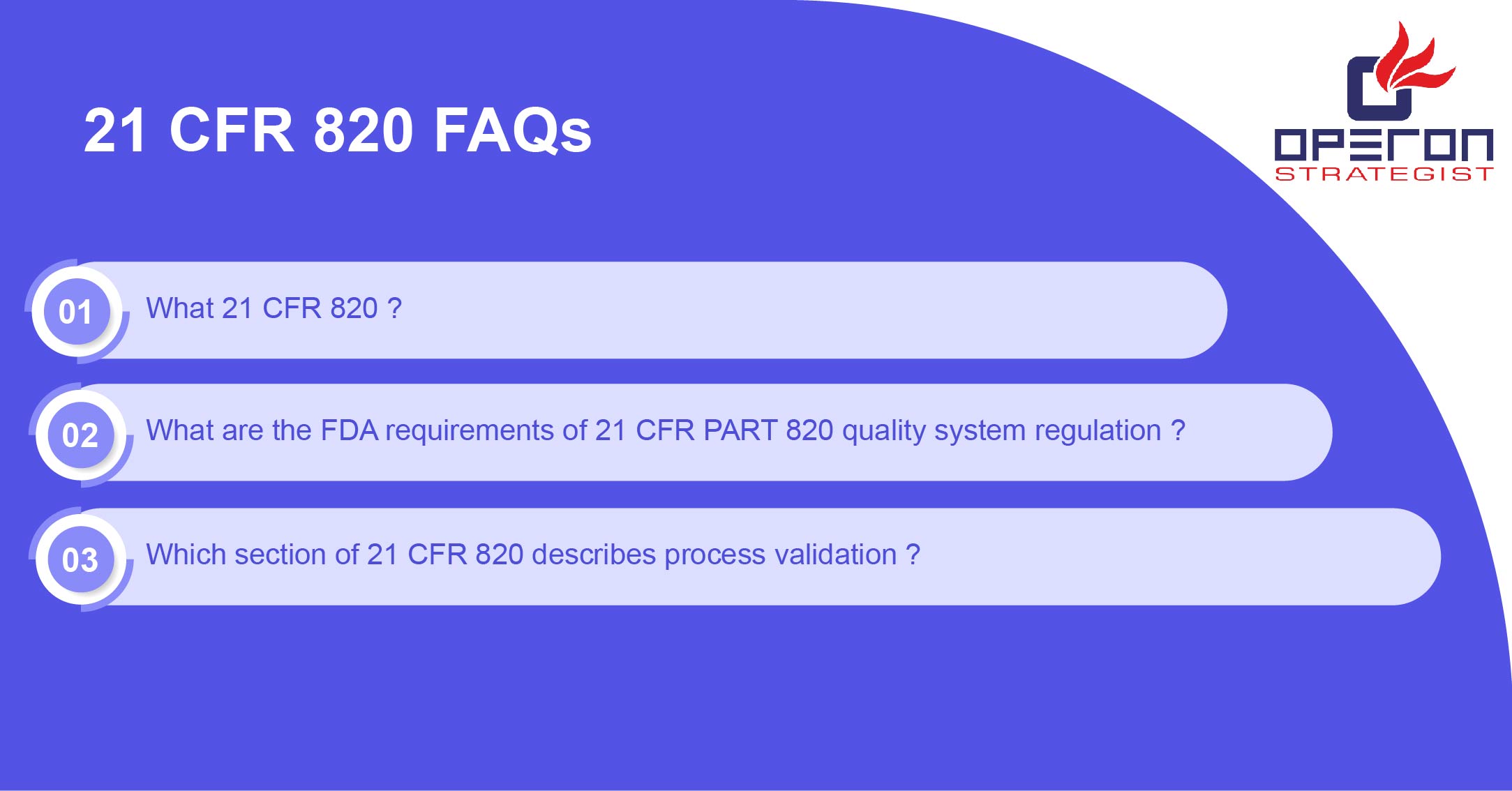21 CFR Part 820 Ensures Your Device is Safe and Effective
The purpose of regulatory affairs is to ensure that your company complies with applicable laws and regulations. These regulations, such as Quality System Regulation 21 CFR Part 820, are intended to ensure devices entering the marketplace are safe and effective.These are some highly important 21 cfr 820 Faqs which will help you out with all your queries regarding it.
Important 21 cfr 820 Faqs
- What 21 cfr 820?
The 21 CFR Part 820 is a set of regulations from FDA that outlines the current good manufacturing practice (CGMP) requirements that medical device manufacturers in the United States must follow with regards to their quality system. These CGMP requirements ensure medical device companies establish a QMS that enables the delivery of safe, effective, and compliant products. As stated by FDA, 21 CFR Part 820 covers “the design, manufacture, packaging, labeling, storage, installation, and servicing of all finished devices intended for human use,” including the facilities and designs used for those processes.
Also Read
- Get to know the importance of the difference between FDA 21 CFR part 820 and iso 13485
- FDA Inspections vs ISO Audits : FDA 21 CFR Part 820 and ISO 13485
21 cfr part 820 For Medical Devices
We have experience with each constituent part and the GMP regulations that together form the basis for their development and manufacture: Drug Device (FDA 21 CFR part 820) and Combination Products (21 CFR Part 4).
What are the FDA requirements of 21 CFR PART 820—quality system regulation?
- 21 CFR PART 820 QUALITY SYSTEM REQUIREMENTS
FDA conducts regular inspections to ensure compliance with its QSR. FDA uses the Quality System Inspection Technique (QSIT) to evaluate the alignment of internal quality system processes with regulatory requirements. The stakes of compliance are clear. Violations can result in 483 observations and warning letters.
It covers management responsibility, internal quality audits, and personnel. This includes a range of roles, as well as what each role is in charge of doing and what training they require. covers management responsibility that includes regulations about policies, resources, and planning:
Quality policy: Commit to quality and ensure the company understands quality, as well as implements and maintains it.
Organization: Use an organizational structure commensurate with the production of compliant medical devices, including handing out appropriate responsibilities to appropriate personnel and providing the resources necessary to meet FDA requirements.
Management review: Review the QMS at regular intervals and document those reviews.
Quality planning: Plan out the practices, resources, and activities that support quality.
Quality system procedures: Set quality system procedures and instructions.
- 21 CFR PART 820—DOCUMENT CONTROLS
It covers document controls. Document control refers to policies and procedures quality managers use to manage documents throughout the medical device product lifecycle.
General: Establish procedures that control documents so that they comply with 21 CFR Part 820.
Document approval and distribution: Designate one person or a group of people to review and approve documents for their compliance.
Document changes: Review document changes in the same fashion you approve and distribute them
21 CFR 820.30 design control For Medical Devices
Operon Strategist the leading medical device 21 CFR 820.30 design control consultants have extensive experience with the practical implementation of design controls regulation for developing new design control processes or for making improvements to existing processes.
Which section of 21 CFR 820 describes process validation?
Section 820.75 – 21 CFR 820 describes Process validation.Where the results of a process cannot be fully verified by subsequent inspection and test, the process shall be validated with a high degree of assurance and approved according to established procedures. The validation activities and results, including the date and signature of the individual(s) approving the validation and where appropriate the major equipment validated, shall be documented.
- 21 CFR Part 820 Subpart C—Design controls
It covers design controls. Design controls are procedures that ensure devices are designed according to their requirements.
- 21 CFR Part 820 of Design Controls includes additional requirements during the design process:
Design and development planning: Have regularly reviewed plans for design and development.
Design input: Ensure design requirements fit the intended use of the device, including a way for manufacturers to address “incomplete, ambiguous, or conflicting requirements.”
Design output: Define and document design outputs in such terms that you can evaluate conformance to design inputs.
Design review: Plan and conduct regular design reviews that include people involved with the reviewed function, people uninvolved, and specialists.
Design verification: Check that design outputs match design inputs.
Design validation: Check that devices, including software, match defined user needs and intended uses. This can involve testing production units.
Design transfer: Translate your device into production specifications.
Design changes: Review design changes before you implement them.
Design history file (DHF): Create a DHF with records that show you designed a compliant device according to your plans.
The FDA regulations apply to finished device manufacturers who distribute commercial medical devices. According to 21 CFR 820.3(l) a finished device is defined as “any device or accessory to any device that is suitable for use or capable of functioning, whether or not it is packaged, labeled, or sterilized.”







